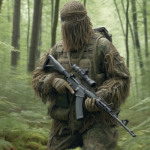A ghillie suit is an essential tool for hunters, military personnel, photographers, and outdoor enthusiasts who seek effective camouflage. Its intricate design, made to mimic natural surroundings, allows users to blend seamlessly into their environment. Here, we provide an in-depth guide on how to use a ghillie suit effectively for maximum concealment.
What is a Ghillie Suit?
A ghillie suit is a type of camouflage clothing designed to resemble heavy foliage or the natural elements of the environment. Typically, it is made from lightweight materials covered in strips of fabric, netting, or threads that mimic grass, leaves, or other natural elements. The primary goal is to disrupt the human silhouette, making the wearer nearly invisible in certain terrains.
Choosing the Right Ghillie Suit for Your Needs
Consider Your Environment
When selecting a ghillie suit, it is crucial to match it with the terrain where you will use it. For example:
- Woodland environments: Opt for suits with green, brown, and dark tones.
- Desert areas: Choose tan and beige tones.
- Snowy landscapes: A white ghillie suit with gray accents works best.
Material and Durability
Look for high-quality materials that can withstand harsh outdoor conditions. Lightweight suits are ideal for mobility, while heavier suits provide enhanced coverage and protection.
Customization
Many suits are designed for personal customization, allowing you to add local foliage or alter the fabric to better match your surroundings.
How to Wear a Ghillie Suit
1. Layer Your Clothing Appropriately
Before wearing a ghillie suit, ensure you are dressed appropriately for the weather and activity. Use moisture-wicking base layers to stay comfortable during prolonged use.
2. Adjust for Comfort and Fit
Ensure the suit fits snugly but allows free movement. Loose suits can snag on branches, while overly tight suits may restrict motion.
3. Secure All Attachments
Properly secure the suit’s components, such as hoods, gloves, and boots, to avoid leaving exposed areas that could give away your position.
How to Customize Your Ghillie Suit
Adding Local Foliage
Incorporating elements from your immediate surroundings significantly enhances your camouflage. Use:
- Twigs and branches to mimic trees.
- Grass and leaves to blend with the forest floor.
- Sand or dirt to create natural discoloration in arid regions.
Using Natural Colors
Use spray paint or fabric dye to enhance the suit’s patterns. Focus on creating uneven, blotchy patterns to mimic the randomness of nature.
Maintenance
Regularly check and clean your suit to prevent odors or the accumulation of dirt that could hinder your concealment.
Using a Ghillie Suit for Hunting
1. Scout the Area First
Before donning your ghillie suit, study the terrain and identify where you can blend in best. Focus on areas with dense foliage or natural barriers.
2. Move Strategically
Minimize movement to avoid detection. When moving:
- Stay low to the ground.
- Move slowly to mimic natural shifts in the environment.
- Use natural shadows to your advantage.
3. Mask Your Scent
Combine your suit with scent-masking sprays to reduce the chances of detection by animals with a keen sense of smell.
Using a Ghillie Suit for Photography
1. Blending into the Environment
Wildlife photographers can use ghillie suits to approach animals without startling them. Choose a vantage point that aligns with the animal’s natural habitat.
2. Ensure Camera Concealment
Cover your camera and gear with camouflage netting or fabric to prevent reflections or unnatural shapes.
How to Maintain and Store Your Ghillie Suit
1. Cleaning
Clean your ghillie suit after every use. Remove debris such as leaves and twigs, and hand wash the suit if necessary.
2. Drying
Always air dry your suit to prevent damage to its materials. Avoid prolonged exposure to direct sunlight, which can weaken fabrics.
3. Proper Storage
Store your suit in a dry, cool area. Use a breathable storage bag to prevent mold or mildew.
Tips for Enhancing Camouflage
Blend Movements with Nature
Even with a ghillie suit, unnatural movements can give away your position. Observe the natural environment and mimic the rhythm of its motion.
Avoid Silhouetting
Position yourself against a backdrop that breaks up your outline. Avoid open spaces where your silhouette may become apparent.
Adapt to Changing Conditions
Natural environments change with time and weather. Regularly update your ghillie suit’s appearance to match new conditions.
Safety Considerations
Be Mindful of Surroundings
Avoid areas with hazardous plants or wildlife. Ensure the suit doesn’t impede your vision or hearing.
Stay Hydrated
Wearing a ghillie suit in warm climates can lead to overheating. Drink plenty of water and take breaks when necessary.
The Importance of Practice
Using a ghillie suit effectively requires practice. Spend time:
- Testing your suit in various terrains.
- Practicing low-crawl movements.
- Observing how your suit interacts with light and shadows.
Mastering the use of a ghillie suit requires patience, strategy, and attention to detail. With proper care and techniques, this tool becomes invaluable for blending seamlessly into any natural setting.
